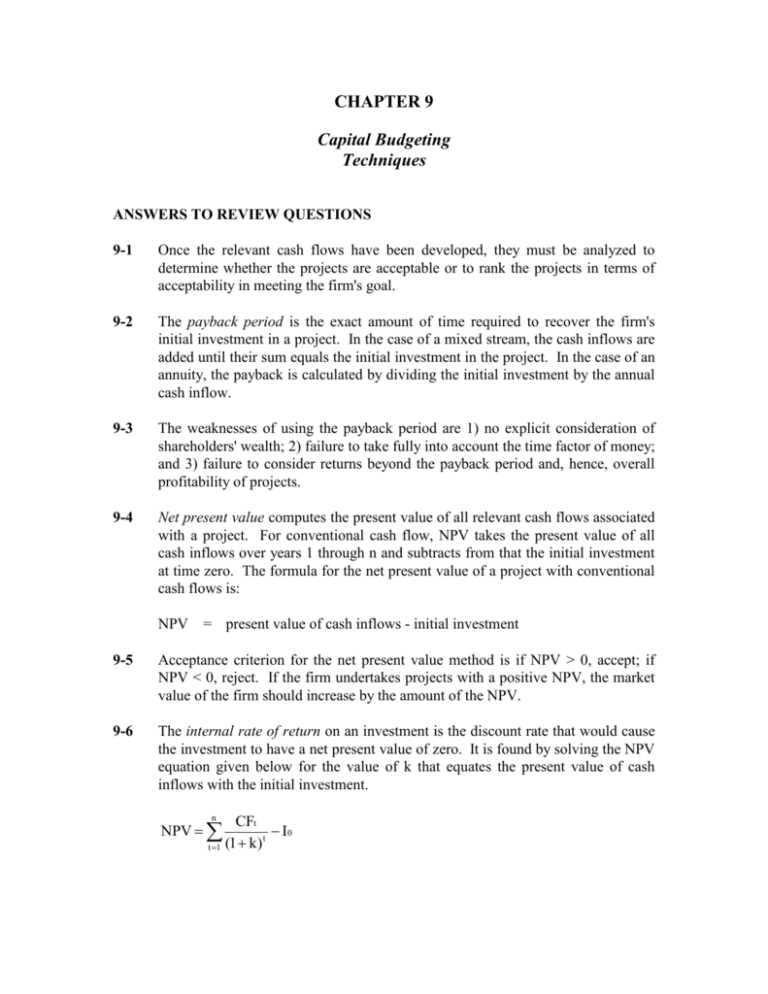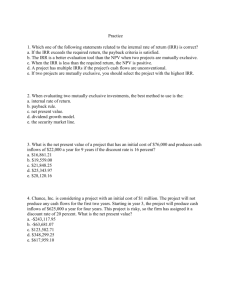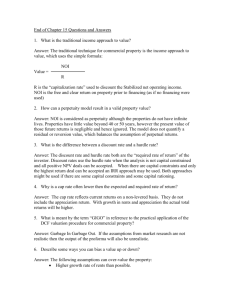CH9 Review
advertisement

CHAPTER 9 Capital Budgeting Techniques ANSWERS TO REVIEW QUESTIONS 9-1 Once the relevant cash flows have been developed, they must be analyzed to determine whether the projects are acceptable or to rank the projects in terms of acceptability in meeting the firm's goal. 9-2 The payback period is the exact amount of time required to recover the firm's initial investment in a project. In the case of a mixed stream, the cash inflows are added until their sum equals the initial investment in the project. In the case of an annuity, the payback is calculated by dividing the initial investment by the annual cash inflow. 9-3 The weaknesses of using the payback period are 1) no explicit consideration of shareholders' wealth; 2) failure to take fully into account the time factor of money; and 3) failure to consider returns beyond the payback period and, hence, overall profitability of projects. 9-4 Net present value computes the present value of all relevant cash flows associated with a project. For conventional cash flow, NPV takes the present value of all cash inflows over years 1 through n and subtracts from that the initial investment at time zero. The formula for the net present value of a project with conventional cash flows is: NPV = present value of cash inflows - initial investment 9-5 Acceptance criterion for the net present value method is if NPV > 0, accept; if NPV < 0, reject. If the firm undertakes projects with a positive NPV, the market value of the firm should increase by the amount of the NPV. 9-6 The internal rate of return on an investment is the discount rate that would cause the investment to have a net present value of zero. It is found by solving the NPV equation given below for the value of k that equates the present value of cash inflows with the initial investment. n CFt I0 t t 1 (1 k ) NPV Part 3 Long-Term Investment Decisions 9-7 If a project's internal rate of return is greater than the firm's cost of capital, the project should be accepted; otherwise, the project should be rejected. If the project has an acceptable IRR, the value of the firm should increase. Unlike the NPV, the amount of the expected value increase is not known. 9-8 The NPV and IRR always provide consistent accept/reject decisions. These measures, however, may not agree with respect to ranking the projects. The NPV may conflict with the IRR due to different cash flow characteristics of the projects. The greater the difference between timing and magnitude of cash inflows, the more likely it is that rankings will conflict. 9-9 A net present value profile is a graphic representation of the net present value of a project at various discount rates. The net present value profile may be used when conflicting rankings of projects exist by depicting each project as a line on the profile and determining the point of intersection. If the intersection occurs at a positive discount rate, any discount rate below the intersection will cause conflicting rankings, whereas any discount rates above the intersection will provide consistent rankings. Conflicts in project rankings using NPV and IRR result from differences in the magnitude and timing of cash flows. Projects with similar-sized investments having low early-year cash inflows tend to be preferred at lower discount rates. At high discount rates, projects with the higher early-year cash inflows are favored, as later-year cash inflows tend to be severely penalized in present value terms. 9-10 The reinvestment rate assumption refers to the rate at which reinvestment of intermediate cash flows theoretically may be achieved under the NPV or the IRR methods. The NPV method assumes the intermediate cash flows are reinvested at the discount rate, whereas the IRR method assumes intermediate cash flows are reinvested at the IRR. On a purely theoretical basis, the NPV's reinvestment rate assumption is superior because it provides a more realistic rate, the firm's cost of capital, for reinvestment. The cost of capital is generally a reasonable estimate of the rate at which a firm could reinvest these cash inflows. The IRR, especially one well exceeding the cost of capital, may assume a reinvestment rate the firm cannot achieve. In practice, the IRR is preferred due to the general disposition of business people toward rates of return rather than pure dollar returns.











